Short assignments
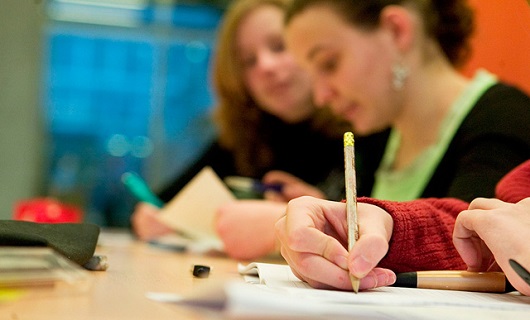 The short assignments offer an easy and accessible entry for your students to dive into the topic of next week’s lecture or to practice academic skills. They help your students to reflect on the content of your course, but also learn them skills such as critical source or object reflection and contextualization, as well as presentation skills like writing for the web, visual presentation, and essay writing.
The short assignments offer an easy and accessible entry for your students to dive into the topic of next week’s lecture or to practice academic skills. They help your students to reflect on the content of your course, but also learn them skills such as critical source or object reflection and contextualization, as well as presentation skills like writing for the web, visual presentation, and essay writing.
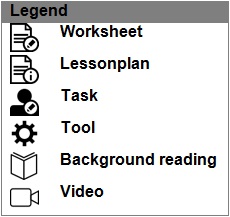 |
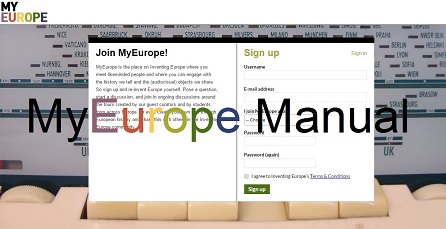 |
Reading assignment
Learning objectives:
- Direct student reading toward specific issues, and encourage lateral thinking.
- Prepare class discussion around concrete examples.
Assignment suggestion:
Read the literature for next week and read one selected tour story from Inventing Europe. Although our time frame is the 19th century and that of Inventing Europe is mostly the 20th century, prepare for debate in class next week by searching for similarities in perspectives and structures. – Charles University, Prague.
Teacher material
| Reading assignment outline |
Student material
| MyEurope | |
| Manual: MyEurope |
Essay assignment
Learning objectives:
- Help students connect structural models of history to concrete examples.
- Develop essay writing skills.
- Develop skills in source criticism.
Assignment suggestion:
Write an essay of max. 2-3 pages. Read the literature on bottom-up European integration history, and explore three stories from the Inventing Europe Virtual Exhibit at www.inventingeurope.eu. Summarize the main characteristics of bottom-up European integration processes and analyze these processes at the hand of the three Inventing Europe stories. If you identify top-down history elements, please describe them as well. Explore the “What’s like this?” sections below the three Inventing Europe stories that you have used, to find relevant objects that support your essay. (ECTS: 20%) – Eindhoven University of Technology, Netherlands.
Teacher material
| Essay assignment outline |
Student material
| Manual: How to Write an Essay | |
| Manual: How to Cite |
Museum visit and paper assignment
|
Learning objective:
|
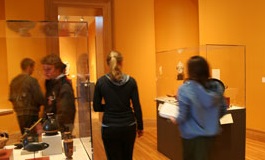 |
Assignment suggestion:
Prepare for next week’s museum visit by reading an Inventing Europe tour about energy. First we have a lecture at the museum. Then we visit the exhibition on the development of energy in Greece. After this, each student writes a one-page report explaining the main difference between the online and the museum exhibition. Tell what you find online, and what you miss in the museum. – National and Kapodistrian University of Athens, Greece.
Teacher material
| Museum visit and paper assignment outline |
Student material
| Manual: How to Create a Tour | |
| Manual: How to Create a Digital Exhibition |
Object contextualization assignment
Learning objectives:
- Students learn to place objects in different historical contexts.
- Students learn to apply source criticism to artefacts and (audio) visual material.
- Students learn to recognize the voice and contexts of different actors.
- Students learnt to contextualize museum collections differently.
Assignment suggestion:
Select from the “Tours” or from the “What’s like this?” section below each of the stories in each of the tours at www.inventingeurope.eu an object, image, or video that intrigues you, and relates to European infrastructures. Tell us: 1) what you find intriguing about this object in max. 100 words; 2) give the metadata for your object; 3) The Object of History Guide discusses 5 ways in which an object can be contextualized by the metadata and the story it is linked to. Analyze and explain briefly how the object of your choice is contextualized in the Inventing Europe virtual exhibit by means of its metadata and accompanying story. – Eindhoven University of Technology, Netherlands; University of Zielona Gora, Poland.

Teacher material
| Object contextualization assignment outline |
Student material
| Manual: How to Contextualize an Object | |
| The Object of History Guide | |
| Lecture Alec Badenoch ‘How to Contextualize Museum Collections in an European and Transnational Context’ |

Copyright assignment
Learning objectives:
- Students learn to engage with the web in an academic way by understanding the role and importance of copyright issues in the online world.
- Students learn to engage critically with digital heritage environments, by dealing with questions of access and authority.
Do you think that everything on the internet is available for free? Have a reality check! Similar to doing historical research in archives and libraries, the use of the internet as a tool for historical audiovisual and textual research is bound by copyrights. Explore Inventing Europe and find a tour that interests you.
Assignment suggestion 1:
Scroll down the stories to the “What’s like this?” section, and take a look at the objects on display. Are there many? Are there videos and audios? Then open the “Adapt search”. Check and adapt both the “Can I use it?” and the “Copyright” filters. What happens to the search results on display? Click here for an explanation of the different categories in the two filters. What influence do these copyrights have on your option to use the different objects for your research? Explain in maximally one-page the implications of copyright for your use of the objects.
Assignment suggestion 2:
Scroll down the stories to the “What’s like this?” section, and select the five most interesting objects for your course assignment/research. Click on the objects and check out their copyright status. What does this copyright mean? For which purposes can you use the object? Can you use it for your assignment? And can you use it if your assignment happened to be a non-scholarly and commercial publication? Click here for an explanation of different types of copyrights. Explain in maximally one page the implications of copyrights for the use of online sources for research purposes.
Teacher material
| Copyright assignment 1 outline | |
| Copyright assignment 2 outline | |
Writing a researched web story assignment
Learning objectives:
- Students learn to write for the web, and recognize how that differs from other writing styles.
- Students learn to search for relevant literature and apply source criticism to online sources.
Assignment suggestion 1:
Explore the Inventing Europe website. Write a short essay on a technical object in the Inventing Europe exhibit style, that is: a short historical context, a short state-of-the-art before the use of the object, the history of the object, and the consequences of its use. - New University of Lisbon, Portugal.
Assignment suggestion 2:
Read carefully the “How to write an academic story for the web?” manual and the excerpts of the Web content style Guide by Garry McGovern. Create a 150-word historically inspired web story about a technological object that you find on Inventing Europe, either in the tours or in the ‘What’s like this?” section below each of the stories in each of the tours. The story needs to be inherently different from the way it was categorized originally. Use the newspaper search engine at www.kb.nl and JStor to find RELEVANT articles for your topic. The story needs to be based on at least one source that has been critically examined and needs to respond to the requirements for stories as explained in the manual. – Eindhoven University of Technology, Netherlands.
Teacher material
| Writing a researched web story assignment 1 outline | |
| Writing a researched web story assignment 2 outline | |
| PowerPoint: How to Write for the Web |
Student material
MEANING OF OBJECTS VERSUS WEB LOCATION ASSIGNMENT
Learning objectives:
- Students learn to engage with the web in an academic way. This includes: contextualizing online objects, developing critical understanding of metadata formats, and engaging in digital source criticism.
- Students learn to engage critically with digital heritage environments.
Assignment suggestion 1:
The purpose of this exercise is to get you to think about the way that online environments frame digital objects. Watch the video on object contextualization by Alec Badenoch, and read carefully the Object of History guide. Find a tour on Inventing Europe that relates to the topic of your course and read it carefully. Then scroll down one of the story pages to the “What’s like this?” section and select an object. What stories or contexts are emphasized by Inventing Europe? Think about the relationships to other objects on the page, the keywords selected for it, etc. Next look at the object on Europeana – note the kinds of metadata and information available for the chosen object, and other connections suggested for it there. Finally, look at the object in its original web environment. What kinds of contexts and narratives are suggested by the metadata and narrative material there?
In a 1-2 page essay, compare and contrast the ways in which the metadata and website environment encourage or limit understanding the item in its various roles: as artefact, object, source, and representation. – Alec Badenoch, Utrecht University, the Netherlands.
Teacher material
| Meaning of objects versus web location assignment outline | |
Student material
| The Object of History Guide | |
| Lecture Alec Badenoch ‘How to Contextualize Museum Collections in an European and Transnational Context’ | |
Presentation assignment
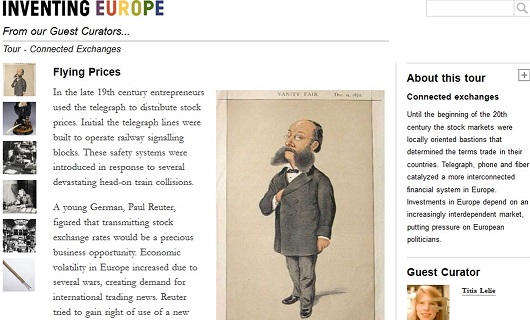 Learning objective:
Learning objective:
- Students learn to present their work by combining research results with audiovisual material.
Assignment suggestion:
Prepare a 10-minute presentation about the tour that your group has created. Each presentation starts with a 1-minute pitch that gives the core conclusion of the tour. The idea is “to sell” your tour and conclusion to the other groups during this 1 minute, explaining why your tour should have a place in the Inventing Europe: European Digital Museum for Science & Technology. Then follows a brief explanation of what, and why, the tour contributes to the theme of the exhibition: “The bottom-up and top-down integration of Europe through infrastructures.” (ECTS: 0.1) – Eindhoven University of Technology.
Teacher material
| Presentation assignment outline |
Student material
| MyEurope | |
| Manual: MyEurope |
INTERNET AS A RESEARCH TOOL (SOURCE CRITICISM) ASSIGNMENT
Learning objective:
- Students learn to engage with the web in an academic way. This includes: contextualizing online objects, relating them to academic research and publications, developing critical understanding of metadata formats, and engaging in digital source criticism.
Assignment suggestion:
This exercise is to help you think about the use of online searches and objects as sources for doing research. Watch the talk by Alec Badenoch on the contextualization of objects. For more background, see also Andreas Fickers “Towards a New Digital Historicism? Doing History in the Age of Abundance”.
Select a story from Inventing Europe that relates to a topic of your interest and formulate a research question for further investigation. You might want to expand on one of the social contexts, for example, or explore similar processes in other countries. Scroll down to the ‘What’s like this?’ section – feel free to adjust the keywords to fit your question. Once you have what seems like a relevant set of results, evaluate them as sources toward answering you research question.
Choose the 3 most relevant results, and explore them in their original contexts. Critique each of your three results as sources for your research.
- Is it clear who created the item?
- Are the date and place of the object specific enough to allow you to use the item in answering your research question?
- What is the relationship of the hosting organization (collector) to the source? Do they hold the original (physical) object? How reliable is the information they provide, and how likely are they to have more? Do they also have related content that would help you to answer your question?
Bearing your answers in mind, turn back to your results as a whole. What role could your results play in the data corpus for your research? What other sources would you need, if any? How would you go about completing your corpus from here? – Alec Badenoch, Utrecht University, the Netherlands.
Teacher material
| Internet as a tool for historical research (source criticism) outline |
Student material
| Lecture Alec Badenoch ‘How to Contextualize Museum Collections in an European and Transnational Context’ | |
| Andreas Fickers, “Towards a New Digital Historicism? Doing History in the Age of Abundance“, View Journal of European Television History & Culture 1, no.1 (2012). |
Understanding the keyword search of online databases assignment
Learning objective:
- Students learn to engage with the web in an academic way. This includes: contextualizing online objects, and engaging in digital source criticism by understanding the role of keyword searches.
- Students learn to engage critically with digital heritage environments.
Assignment suggestion:
Internet searches are based on matching relevant data, and sorted according to a number of patterns. In this exercise, you will examine, and critically evaluate whether and how relevant links are made. Select a tour from Inventing Europe. Note the contexts in which the object is placed and the narrative that the story develops. Select one object from the tour and scroll down to the “What’s like this?” section and look at the key words. How do they relate to the object? How do they relate to the context of the story?
Select the top three results. What keywords were important in making the link? Where are they found in the metadata of each object (title, description, etc.)? Are the results relevant to the story told in Inventing Europe? Try to adjust the keywords to generate a more relevant result. (If you think they are already relevant, think of a different story you might tell about the same object for which the presented results are less relevant, and try to adjust the keywords accordingly). How did you go about this (narrowing or broadening categories, adding or subtracting a search word)? Why was this more effective?
Based on your observations, describe in your own words how relevance is determined by the search function in Inventing Europe. – Alec Badenoch, Utrecht University, the Netherlands.
Teacher material
| Understanding the keyword search of online databases outline |
Thinking through digital (European) connections assignment
Learning objective:
- Students learn to engage with the web in an academic way. This includes: contextualizing online objects, relating them to academic research and publications, developing critical understanding of metadata formats, and engaging in digital source criticism.
Assignment suggestion:
Watch the keynote lecture by Alec Badenoch on contextualizing objects in (European) connections. In the introduction, he talks about the ways that search results can suggest new connections you might not have thought of (in this case, the Scottish diaspora). In this assignment, you are asked to think creatively about what kinds of connections your search results might reveal.
Find a tour that relates to the topic of your course. Scroll down to the “What’s like this?” section which can be found below each of the stories within this tour.
For the first 10 results (at least) note briefly:
- What connections does it have with the object in the above story? Don’t just note the keyword, but think about what contexts they might have in common.
- What connects it to the other objects?
Make particular note of any surprises. Based on your observations, write a short research proposal to explore the historical connections or phenomenon you see emerging from your results, culminating in a solid research question and suggestions for how you could go about pursuing it further. – Alec Badenoch, Utrecht University, the Netherlands.
Teacher material
| Thinking through digital (European) connections outline |
Student material
| Lecture Alec Badenoch ‘How to Contextualize Museum Collections in an European and Transnational Context’ |
Online heritage as source for material research assignment
Learning objective:
- Students learn to engage with the web in an academic way. This includes: contextualizing online objects, and relating them to academic research and publications.
Assignment suggestion:
In this assignment, we ask you to think about how material content is translated into the online world, and what implications digitization and online display have for how we understand and research the histories of objects. Begin with selecting one story from a tour on Inventing Europe. For the object used in the story item, note:
- What is its physical counterpart? (i.e. what does it represent? eg. a photo, a three-dimensional object, a taped sound recording, etc.)
- Does that physical counterpart still exist?
- What aspects of the object does the story on Inventing Europe bring forward? Does it talk about what this object represented? Does it talk about the way these kinds of objects were used? Does it talk about the story of this specific object? Are those aspects visible in its digital representation?
- What other aspects of the object does its representation emphasize?
Now scroll down to the “What’s like this?” section and ask the same questions for 5 relevant related objects. Would you be able to analyze them all in comparable ways? Based on your observations, write a 1-page essay, or create a 5-minute video, in which you address the question: what kinds of stories do the digital objects allow us to tell? What kinds of stories can’t we tell? How could these be improved? – Alec Badenoch, Utrecht University, the Netherlands.
Teacher material
| Online heritage as source for material research outline |
Student material
| De Rijcke & Anne Beaulieu, “Images as interface: Consequences for Users of Museum Knowledge“, Library Trends 59, no.4 (2011), 663-685. |









